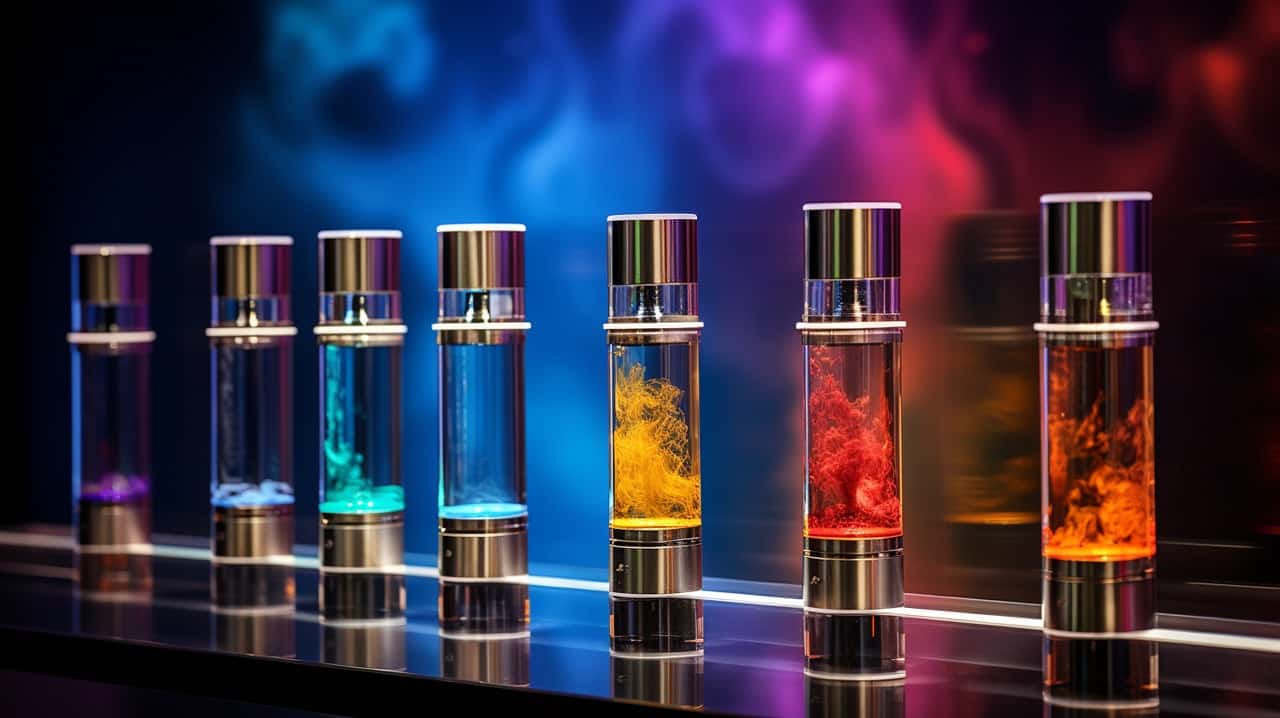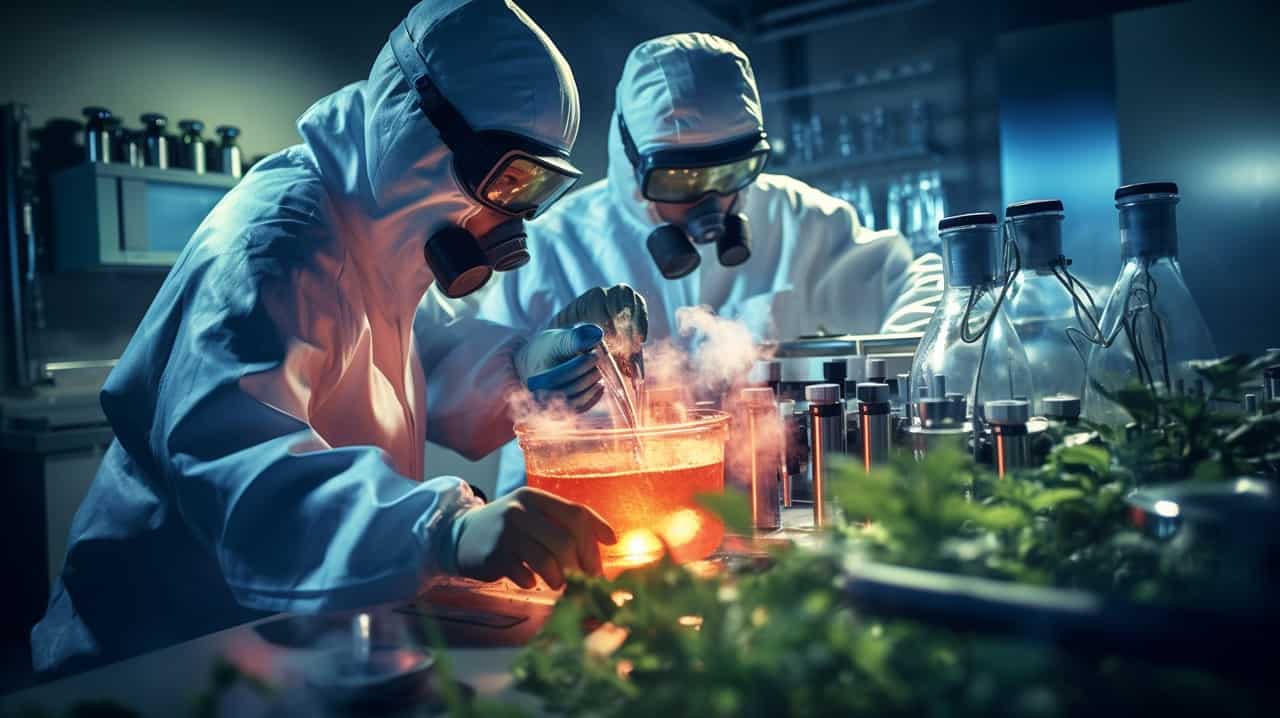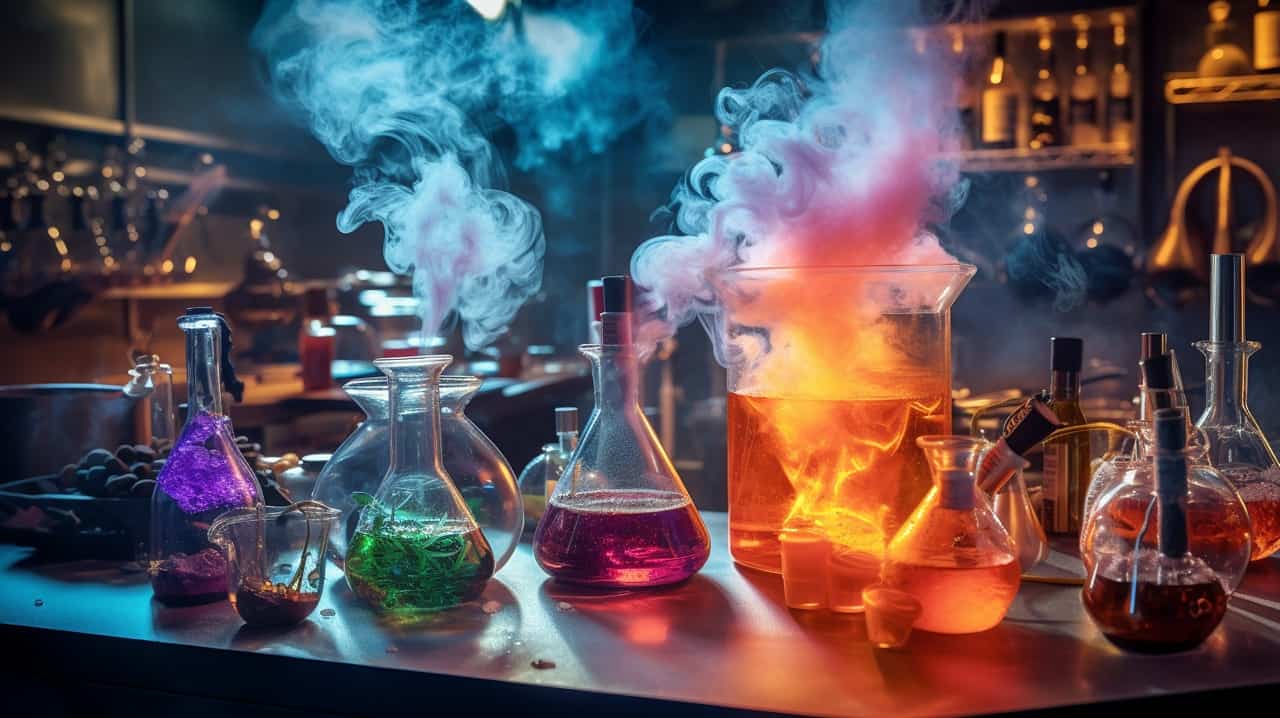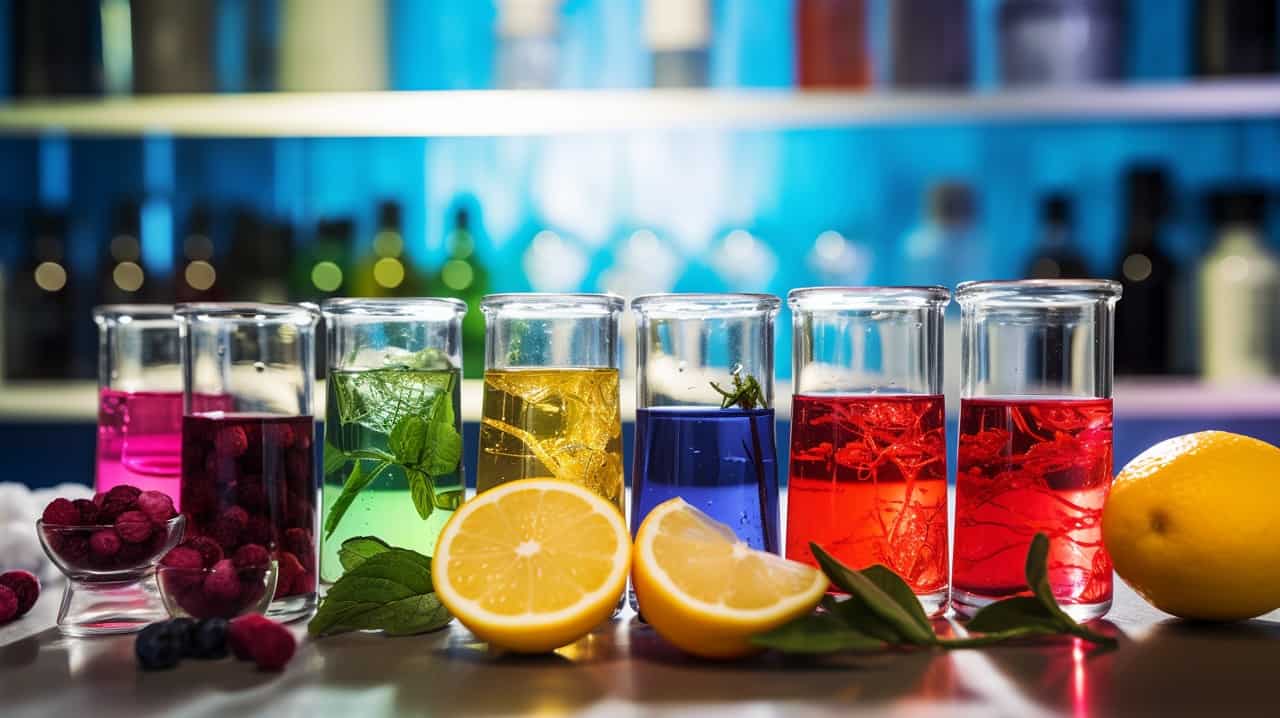Does the world of e-cigarettes seem as hazy as the clouds they produce? If so, you’re not alone; I’ve also been bemused by the complex chemistry behind vaping. After diving into a sea of research, I’ve emerged with clear insights and understandings about what’s really in that vape cloud.
Ready to unravel the science of e-juice together? Let’s get started!
Key Takeaways
E-cigarettes work by heating up e-juice, which contains nicotine, flavorings, and other chemicals, turning it into an aerosol mist that users inhale.
The flavor in e-juice is created through a chemical reaction between flavorings and propylene glycol. However, this process can also lead to the formation of potentially harmful compounds like formaldehyde.
There are potential health risks associated with vaping, including harm to lung cells and the potential for inflammation, chronic cough, and asthma. More research is needed to fully understand the long-term effects of vaping.
Table of Contents
Understanding E-cigarettes and Vaping

E-cigarettes are electronic devices that simulate the act of tobacco smoking by producing an aerosol or “vapor” that is inhaled.
What are e-cigarettes?
E-cigarettes make up a sleek class of electronic devices designed to mimic traditional smoking. They often take the form of pens or even USB drives, containing small batteries that power an atomizer.
This atomizer heats a liquid known as e-juice or vape juice, turning it into vapor for users to inhale. Despite their novel appearance and often sweet flavors, these gadgets have been linked to serious health issues, especially among young people.
Shockingly, there has been an outbreak of lung illness in the US tied to e-cigarette use with hundreds affected and dozens dead already – many victims remarkably young and previously healthy individuals.
What is vaping?
Vaping involves inhaling and exhaling an aerosol, often referred to as vapor, produced by an e-cigarette or similar device. It’s not a smoke from burning tobacco, but the term is used because e-cigarettes don’t produce cigarette smoke but rather an aerosol.
The user sucks on a mouthpiece that activates a battery-powered atomizer in the device causing it to heat up and convert ‘e-juice’ into vapor.
The ‘e-juice’, also known as vape juice or vape liquid, contains nicotine (which is extracted from tobacco), flavorings, chemical additives, and other harmful substances like heavy metals and tiny particles that can be inhaled deeply into lungs.
Vape users get their nicotine without burning tobacco hence making it seem safer than regular cigarettes. Yet public health officials already warn about possible long-term effects of vaping due to these chemicals found in vapes.
How do e-cigarettes work?
E-cigarettes deliver a nicotine-filled experience, without the need for tobacco combustion. Here’s an elementary rundown of their function:
- E-cigarettes use a battery-powered heating element known as the atomizer.
- The atomizer heats up and vaporizes the e – juice when you take a puff.
- E – juice is a liquid solution that contains nicotine, flavorings, and solvents like propylene glycol or glycerin.
- Once heated, this e – juice turns into an aerosol mist instead of true vapor which is then inhaled by the user.
- This non-combustion method separates e-cigarettes from traditional ones, where tobacco leaves are burnt to produce smoke with nicotine and carcinogens.
- Some flavors of e – juice may contain unsafe flavor chemicals that may break down when heated, producing potential inhalation toxins like formaldehyde.
- These levels of flavor chemicals in some e – cigarette fluids can exceed recommended limits—another cause for concern for users.
The Common Ingredients in E-juice

E-juice commonly contains nicotine, flavorings, and propylene glycol and vegetable glycerin.
Nicotine
Nicotine is a common ingredient found in e-juice used in e-cigarettes. It’s the same addictive substance that makes smoking conventional cigarettes difficult to quit. When you vape, the nicotine gets absorbed into your bloodstream through the lungs, giving you a quick rush of pleasure.
Additionally, chronic, low-level stimulation of irritant receptors from nicotine vaping could potentially lead to inflammation, chronic cough, and asthma. It’s important to be aware of the potential health risks associated with nicotine use and understand how it affects your body.
Flavorings
Flavorings play a crucial role in creating the unique taste of e-juice. These flavorings are made up of different chemicals that give each vape liquid its distinct flavor profile. However, it’s important to note that some flavorings may have adverse effects on our health.
For example, cinnamon flavors have been found to harm lung cells and trigger inflammation, chronic cough, and asthma. Additionally, there can be hidden chemicals present in commercial vape juices that are not listed on the ingredients label.
When researchers created their own e-liquid based on known formulations, they discovered new chemicals in the vapor that were even more effective at triggering irritation receptors than the original flavors themselves.
Propylene Glycol and Vegetable Glycerin
Propylene glycol and vegetable glycerin are two key ingredients commonly found in e-juice used for vaping. They play a crucial role in both flavor and vapor production. When these ingredients react with flavorings, they create the unique taste that vapers enjoy.
Additionally, propylene glycol and vegetable glycerin are responsible for producing the aerosol or “vapor” that users exhale. It’s important to note that some commercial vape juices may contain chemicals produced by this reaction, even if they’re not listed on the label.
Research has shown that these new compounds can actually be more irritating than the original flavors themselves. So, when it comes to vaping, understanding the chemistry behind propylene glycol and vegetable glycerin is essential for a satisfying experience.
The Chemistry of E-Juice

Discover the fascinating role of one proton in creating flavors and even formaldehyde in e-juice, and the science behind aerosol production. Dive into the chemistry of e-juice and explore how it affects your vaping experience.
Importance of one proton
One proton may seem small, but it plays a crucial role in the chemistry of e-juice. This tiny particle determines the flavor and allows for the formation of formaldehyde when vaping.
Additionally, one proton is also responsible for the production of aerosol or “vapor”. Its significance cannot be underestimated as it influences both the taste and experience of using e-cigarettes.
Understanding this importance can help us better appreciate how e-juice works and its effects on our health.
Flavor and Formaldehyde Formation
I was fascinated to learn that the flavor in e-juice is created through a chemical reaction between flavorings and propylene glycol. But here’s something you might not know: this process can also lead to the formation of formaldehyde, a potentially harmful compound.
When researchers analyzed commercial vape juices, they discovered that chemicals produced from this reaction were present, even if they weren’t listed on the ingredients label. And when they made their own e-liquid based on known formulations, new chemicals appeared in the vapor.
In fact, these newly formed chemicals were found to be more effective at triggering irritant receptors than the original flavors themselves! It just goes to show how important it is for manufacturers and regulators to carefully consider the potential health risks associated with flavoring agents in e-juice.
Production of Aerosol or “Vapor”
E-cigarettes don’t actually produce vapor, but rather an aerosol mist that resembles vapor. When you inhale from an e-cigarette, the battery-powered atomizer heats up the e-juice inside, which contains ingredients like nicotine and flavorings.
This heating process turns the liquid into a fine mist that you can then inhale. It’s important to note that this aerosol mist may contain harmful substances such as formaldehyde, especially when certain flavor compounds in the e-juice break down at high temperatures.
So while it may look like harmless vapor, it’s essential to understand that there are potential risks associated with inhaling this aerosol mist produced by e-cigarettes.
Health Effects of E-cigarettes

E-cigarettes have been linked to known health effects such as lung illnesses, and there are potential risks and safety considerations associated with their use.
Known health effects
I want to talk about the known health effects of vaping. As a geek, I know that it’s important to stay informed about any potential risks. Here are some of the health effects associated with e-cigarette use:
- Cinnamon flavors in e – cigarettes can harm lung cells.
- Chemicals produced from the reaction between flavorings and propylene glycol are present in commercial vape juices, even if not listed on the ingredients label.
- When researchers created their own e – liquid, approximately 50 to 80 percent of new chemicals were found in the vapor.
- These new chemicals triggered irritant receptors more effectively than the original flavors themselves.
- Chronic, low – level stimulation of these irritation receptors could potentially lead to inflammation, chronic cough, and asthma.
- Further research is needed to understand the long-term effects of mixing and storing e-liquid ingredients.
Potential risks and safety considerations
I want to highlight some potential risks and safety considerations associated with vaping. Here are some key points to keep in mind:
- The recent outbreak of mysterious lung illnesses has raised concerns about the long-term effects of e-cigarettes.
- The exact cause of these illnesses is still unknown, but it could be related to product contamination, THC use, and device modification.
- Public health officials have warned about the potential risks of vaping, but more research is needed to fully understand these risks.
- Sales of e – cigarettes to individuals under 18 are illegal in an effort to prevent teen use, but many students still report regular use.
- Michigan and San Francisco have implemented bans on flavored e – cigarettes, suggesting that further regulation may be necessary.
- Chemicals produced by the reaction between flavorings and propylene glycol can harm lung cells and trigger irritant receptors more effectively than the original flavors themselves.
The Role of E-Juice in Vapor Production and Flavor
E-Juice plays a crucial role in both the production of vapor and the creation of flavor in e-cigarettes.
The science behind flavor creation
When it comes to e-cigarettes, the science behind flavor creation is fascinating. Flavor compounds in e-juice are responsible for the wide variety of tastes and sensations that vapers experience.
These flavor compounds are carefully selected and mixed to create delicious flavors like fruit, dessert, and even tobacco.
But how are these flavors created? It all starts with a combination of natural and artificial ingredients. Flavors can be derived from fruits, spices, or other food sources, while others are synthesized in a lab using chemicals specifically designed to mimic certain tastes.
The process of creating a flavor involves extracting or synthesizing specific compounds that give foods their unique taste profiles. For example, fruity flavors may contain esters or aldehydes that provide sweet or tangy notes.
On the other hand, creamy flavors might include molecules that mimic buttery or milky textures.
Once these individual flavor compounds have been extracted or synthesized, they are combined in precise ratios to achieve the desired taste profile. This is where the skill and expertise of flavor chemists come into play – they must strike the perfect balance between different components to create an enjoyable and harmonious blend.
How vapor is produced
Vapor in e-cigarettes is produced by heating e-juice or e-liquid. This process involves several steps and interactions between the ingredients. Here’s a breakdown of how vapor is produced:
- Heating: When the e-cigarette is activated, the atomizer heats up, which in turn heats the e-juice.
- Vaporization: The heat causes the liquid in the e-juice to turn into vapor, which then can be inhaled.
- Nicotine Release: As the e-liquid vaporizes, it releases nicotine into the vapor.
- Flavor Release: Along with nicotine, flavorings from the e-juice are also released into the vapor.
- Aerosol Formation: The vapor combines with other particles, such as tiny droplets of solvent or flavor compounds, to form an aerosol mist that can be seen when exhaling.
- Inhalation: The user inhales this aerosol mist, allowing them to experience both the nicotine and flavorings present in the e-liquid.
Can E-cigarettes Help People Quit Smoking?
E-cigarettes have been marketed as a potential tool to help people quit smoking, but the scientific evidence is still inconclusive. While some studies suggest that using e-cigarettes can reduce tobacco cravings and help individuals transition away from conventional cigarettes, others show that many smokers end up dual-using both e-cigarettes and regular cigarettes.
It’s important to note that e-cigarettes are not FDA-approved smoking cessation devices, and their long-term effects on health are still unknown. Additionally, the high nicotine content in some e-cigarette liquids can be addictive, which may make it harder for individuals to quit altogether.
If you’re looking to quit smoking, it’s best to consult with a healthcare professional who can provide personalized guidance and support tailored to your specific needs.
Frequently Asked Questions About the Science of E-Juice
What is e-juice and how is it made?
E-juice, also known as vape juice or e-liquid, is a liquid used in electronic cigarettes to create vapor. It is typically made by mixing propylene glycol (PG), vegetable glycerin (VG), flavorings, and nicotine (optional) in specific ratios.
How does the chemistry of e-juice affect flavor and vapor production?
The chemistry of e-juice plays a crucial role in determining the flavor profile and vapor production. The ratio of PG to VG affects the thickness of the liquid and can influence the intensity of both flavor and throat hit. Flavorings are added to provide different tastes, while nicotine contributes to throat hit sensation.
Are there any safety concerns associated with vaping e-juice?
While vaping is generally considered safer than smoking traditional cigarettes, there are still some potential safety concerns with using e-juice. Overheating or improper handling of batteries can cause accidents, certain chemicals used in flavorings may pose health risks when heated and inhaled over long periods.
Can I make my own e-juice at home?
Yes, it is possible to make your own e-juice at home; however, it requires proper knowledge about mixing ratios, quality ingredients from reputable sources, hygiene practices, equipment safety measures & understanding how these interact chemically.To ensure safety and desired results, it’s advisable for beginners or those without experience seek guidance from experts or reliable resources before attempting DIY recipes.
Conclusion
In conclusion, understanding the science behind e-juice is crucial in order to fully comprehend the potential risks and benefits of vaping. The chemistry involved in flavor creation and vapor production highlights the complexity of these products.
It is important for researchers, regulators, and consumers to continue studying e-cigarettes and their effects in order to make informed decisions about their use.


